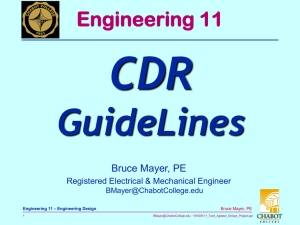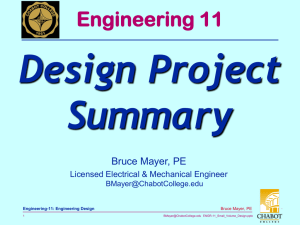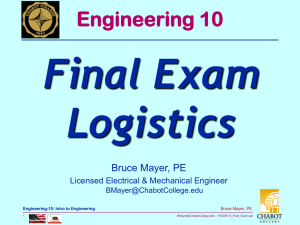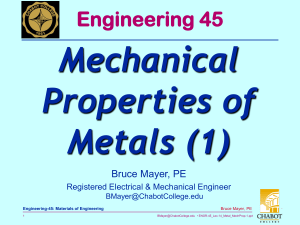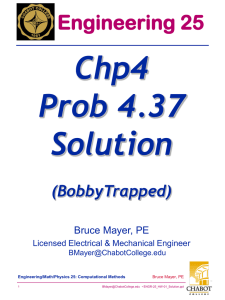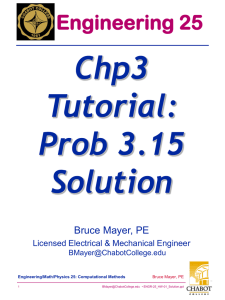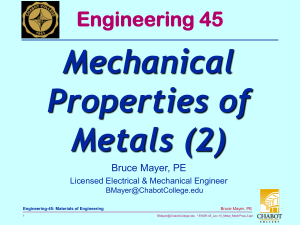Electrical Properties-3 Engineering 45 Bruce Mayer, PE
advertisement
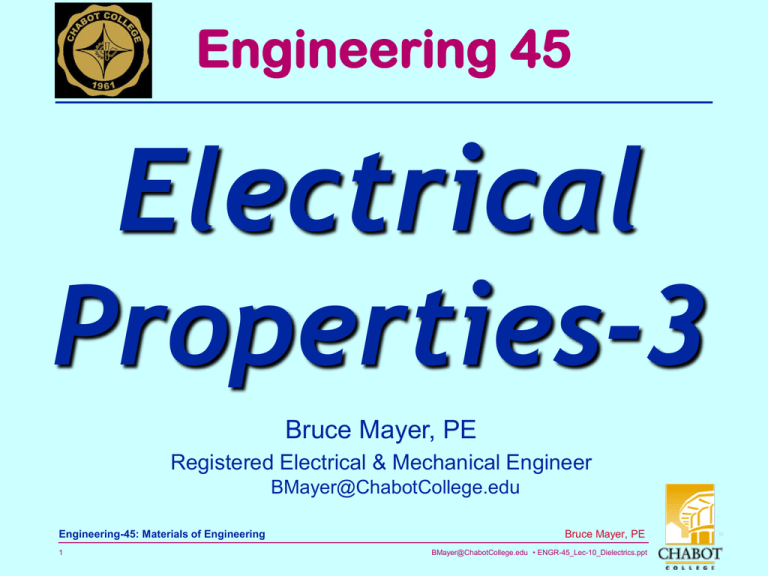
Engineering 45 Electrical Properties-3 Bruce Mayer, PE Registered Electrical & Mechanical Engineer BMayer@ChabotCollege.edu Engineering-45: Materials of Engineering 1 Bruce Mayer, PE BMayer@ChabotCollege.edu • ENGR-45_Lec-10_Dielectrics.ppt Learning Goals – Dielectrics Understand the fundamentals of Electrical Capacitance How Certain Materials can Dramatically Increase the Electrical Capacity Understand Dipoles and Polarization Learn the Types of Polarization Dielectric-Constant vs Frequency Behavior Engineering-45: Materials of Engineering 2 Bruce Mayer, PE BMayer@ChabotCollege.edu • ENGR-45_Lec-10_Dielectrics.ppt Electrical Capacitance Consider Two Conductive Plates Separated by a Small & Empty Gap With a Voltage Applied (right) The Quantity of the Since No Current Can Separated Charge, Q, Flow Across The Gap is Proportional to V • Positive Charges Accumulate on Top • Negative Charges Accumulate on Bot Engineering-45: Materials of Engineering 3 QV Look for Constant of Proportionality, C Bruce Mayer, PE BMayer@ChabotCollege.edu • ENGR-45_Lec-10_Dielectrics.ppt Electrical Capacitance cont. The Value of C can Found from an Expression that is Analogous to Ohm’s Eqn Q CV • Where – Q Charge (A-s or Coulombs) – V Elect. Potential (V) – C Capacitance (A-s/V or Coul/V or Faradays [Farads, F]) Engineering-45: Materials of Engineering 4 • For || plates in a Vacuum C is proportional to the Plate AREA, and the inverse Separation LENGTH A C l Bruce Mayer, PE BMayer@ChabotCollege.edu • ENGR-45_Lec-10_Dielectrics.ppt Electrical Capacitance cont.2 Introducing a Constant of proportionality between C & A/ℓ A C ε0 l • Where – A Plate Area (sq-m) – l Plate Distance (m) – 0 Permittivity of Free Space (vacuum) = 8.85x10−12 F/m Engineering-45: Materials of Engineering 5 • Filling The Gap with a NONconductive Material INCREASES the Charge Accumulation Thru the DiElectric Effect Bruce Mayer, PE BMayer@ChabotCollege.edu • ENGR-45_Lec-10_Dielectrics.ppt Electrical Capacitance cont.3 For a DiElectric Filled Cap • A Cε l Where – Permittivity of the Dielectric Medium (F/m) Using 0 as a BaseLine, Define a Material’s RELATIVE Dielectric Constant Engineering-45: Materials of Engineering 6 r ε ε0 • Sometimes called “k”, the Dielectric Constant is ALWAYS Positive with a Magnitude greater than Unity Bruce Mayer, PE BMayer@ChabotCollege.edu • ENGR-45_Lec-10_Dielectrics.ppt Electrical Terms Electric Field is the ratio of a Voltage Drop to Distance over Which the Drop Occurs; to whit Ε V l units V / m Now as V Increases toward at Some Point the Dielectric will “Break Down” Engineering-45: Materials of Engineering 7 and Current will Flow Thus the Dielectric E-Field Strength Εbd Vi flow l units V / m Bruce Mayer, PE BMayer@ChabotCollege.edu • ENGR-45_Lec-10_Dielectrics.ppt Examples For Air at Room • r = 1.00059 6 V/m (75 V/mil) • E = 3 x 10 bd Conditions Engineering-45: Materials of Engineering 8 Bruce Mayer, PE BMayer@ChabotCollege.edu • ENGR-45_Lec-10_Dielectrics.ppt Electric DiPole What is a “DiPole”? • DiPole Refers to the Physical SEPARATION of TWO, OPPOSITEpolarity, and thus Attractive, “Charge Entities” Two Classical Types • Electric DiPole • Magnetic DiPole – “North” and “South” “Poles” Separated Note: These Entities ALWAYS exist in Tandem; There is NO Magnetic MonoPole – “+” & “-” Charges Separated Engineering-45: Materials of Engineering 9 Bruce Mayer, PE BMayer@ChabotCollege.edu • ENGR-45_Lec-10_Dielectrics.ppt Field Vectors cont Consider an Electric DiPole with Charge, q, and Separation, d • Direction Neg→Pos We call this a “Moment” because of the the DiPole can be Twisted • The Torque Can Be applied with an Electric Field The DiPole Moment, p, is Quantified • Magnitude = q•d Engineering-45: Materials of Engineering 10 Not Aligned →Torque Aligned →NO Torque • The Process of Pole Alignment is called “polarization” Bruce Mayer, PE BMayer@ChabotCollege.edu • ENGR-45_Lec-10_Dielectrics.ppt Field Vectors cont.2 Consider again the ||-Plate Cap The Areal Density of Charges on Each Plate, D Q CV A V • Since a Cap Configuration l “Displaces” Charges from Q V one Plate to Another, The D V E D A l l Quantity D is also Called • Where the DIELECTRIC (charge) – & E from Before DISPLACEMENT – D Charge Density (Coul/sq-m) Engineering-45: Materials of Engineering 11 Bruce Mayer, PE BMayer@ChabotCollege.edu • ENGR-45_Lec-10_Dielectrics.ppt Origins of DiElectric Constant Consider Two Caps: One in a Vacuum, and one with a Dielectric Material Between the Plates Charge on the Vacuum Plates = Q0 Then The Dielectric Slides Between the Plates and DiPoles Align to the E-Field • i.e. The DiElectric Becomes Electrically POLARIZED – See (b) Adding the DiElectric Increases the Plate Charge to Q0+Q’ The Dielectric Charges Nearest the Plates Orient Oppositely to the Added Plate Charge – See (c) Engineering-45: Materials of Engineering 12 Bruce Mayer, PE BMayer@ChabotCollege.edu • ENGR-45_Lec-10_Dielectrics.ppt Origins of DiElectric Const cont. • Note that Regions Removed from the Dielectric Surface Do Not Contribute to the ElectroStatic Balance, and thus this region is Electrically NEUTRAL The Dielectric Surface Charge Tends to Cancel the Vacuum Charge • Hence the Battery Must Supply added Charge to Bring the interface Regions to Electrical Neutrality – This Occurs withOUT an increase in V; and to the Q/V quotient (C) increases Quantify the Increase in D as D 0 E P Engineering-45: Materials of Engineering 13 Bruce Mayer, PE BMayer@ChabotCollege.edu • ENGR-45_Lec-10_Dielectrics.ppt Origins of DiElectric Const cont D 0 E P • Where – P is the DiElectric POLARIZATION charge, (Coul/sq-m) In Concept, P → TOTAL DiPole Moment Per Unit-Volume for the Dielectric Material For Many DiElectrics P 0 r 1E • Capital-P Units Should be Coul/sq-m AND dipole-moments/cu-m Engineering-45: Materials of Engineering 14 P vs p Units Analysis p q d Coul m Coul Coul m P 2 2 m m m Coul m p P m3 m3 Bruce Mayer, PE BMayer@ChabotCollege.edu • ENGR-45_Lec-10_Dielectrics.ppt Polarization Types Electronic • The Applied Field Displaces the e- “cloud” relative to the Nucleus, resulting in noncoincident charge centers – Occurs to some Extent in all Atoms Orientation • Occurs Only in Materials that have PERMANENT Dipole Moments (atomic or molecular) • The Field Polarizes the Originally Randomly oriented Dipoles Engineering-45: Materials of Engineering 15 Bruce Mayer, PE BMayer@ChabotCollege.edu • ENGR-45_Lec-10_Dielectrics.ppt Polarization Types cont. Ionic • The Applied Field Causes Relative Displacement of the Anion and Cation Charge Centers Which Causes a Net Dipole Moment • The Magnitude of The Dipole Moment for each ion pair: pi q di • Where – di Relative Displacement (m) Engineering-45: Materials of Engineering 16 Total Polarization for any Material is the Sum of the Three Constituent Types Ptot Pe Pi Po Bruce Mayer, PE BMayer@ChabotCollege.edu • ENGR-45_Lec-10_Dielectrics.ppt Frequency Dependence AC Electric signals Are often Applied at High Frequencies to Capacitive Materials Since Dipole Alignment MUST have some FINITE Relaxation Time, r, Expect some Dielectric Frequency Dependence Engineering-45: Materials of Engineering 17 • At Frequencies, fr, That exceed 1/r DiPoles CanNOT keep Up with the Applied Field; Reducing the Dielectric Effect Bruce Mayer, PE BMayer@ChabotCollege.edu • ENGR-45_Lec-10_Dielectrics.ppt r Comparison Relaxation Frequency, fr, progression • Fastest → Electronic • Medium → Ionic • Slowest → Orientation Engineering-45: Materials of Engineering 18 Bruce Mayer, PE BMayer@ChabotCollege.edu • ENGR-45_Lec-10_Dielectrics.ppt All Done for Today Electrical Capacity Engineering-45: Materials of Engineering 19 Bruce Mayer, PE BMayer@ChabotCollege.edu • ENGR-45_Lec-10_Dielectrics.ppt WhiteBoard Work Let’s Work Prob 18.59W • Given, Polarization P = 10-6 Coul/sq-m • Find r for E = 50 kV/m • Calculate the Electric Charge Displacement, D Engineering-45: Materials of Engineering 20 Bruce Mayer, PE BMayer@ChabotCollege.edu • ENGR-45_Lec-10_Dielectrics.ppt


